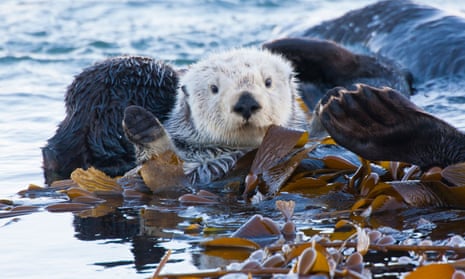Before the fur trade drove them to near extinction, sea otters once roamed the waters of North America from Alaska to Baja California. Now a non-profit conservation group wants to see them brought back, and say the otters could help restore the region’s crucial but decimated kelp forests.
The Center for Biological Diversity has petitioned the US Fish and Wildlife Service (USFWS) to reintroduce the furry mammals to a large swath of the west coast stretching from northern California to Oregon, pointing to the vital role otters play in the coastal ecosystem. A small population of southern sea otters lives on California’s central coast, where the Monterey Bay Aquarium regularly documents their adventures, but the threatened animal occupies just 13% of its historic range.
“There’s this big gap between the San Francisco Bay Area through Oregon where there are no sea otters,” said Emily Jeffers, an attorney in the oceans program at the Center for Biological Diversity. “They are really important to coastal ecosystems but they are just missing from a huge chunk of our coastline.”

The animals help keep sea urchin populations in check, which is vital to protect kelp forests – in northern California, 95% of kelp forests have disappeared due to urchin barrens. Reintroduction of otters is necessary to bring the animals back to their historic US range, recover the threatened southern sea otter and restore important coastal ecosystems including kelp forests and seagrass beds, the Center for Biological Diversity wrote in its letter to the federal government.
The center also asked the USFWS to assess the feasibility of reintroducing the otter from southern California into Baja California, Mexico.
“Bringing the sea otter back to the broader west coast would be an unparalleled conservation success story,” Kristin Carden, a former senior scientist at the center, said in a statement. “Not only would the sea otters thrive, but they would also help restore vital kelp forest and seagrass ecosystems.”
Last year the USFWS announced the results of a sea otter feasibility assessment in which the agency found that reintroducing the animal along the Pacific coast is biologically and socioeconomically feasible, and would “result in significant conservation benefits to the species … and to the nearshore marine ecosystem”.
The Monterey Bay Aquarium, which has worked with the USFWS to help the recovery of the sea otter population, has publicly supported reintroduction efforts, describing it in a statement as “a promising strategy for returning the species to other parts of its historical range along the California coast”.

The sea otter, which is the smallest marine mammal in North America at up to 4ft long and 70lbs, use a thick layer of fur to stay warm in the cold Pacific waters. In the 18th and 19th centuries, fur traders nearly drove the species to extinction for their warm pelts, killing 99% of the global population, Jeffers said.
Today the populations face risks from oil spills, low genetic diversity and disease. Reintroduction is not unprecedented – such efforts have helped re-establish populations along other parts of the coast.
“Sea otters are important to healthy oceans, healthy coastlines. If we want to see our coastlines thrive, sea otters need to be a part of them,” Jeffers said.
